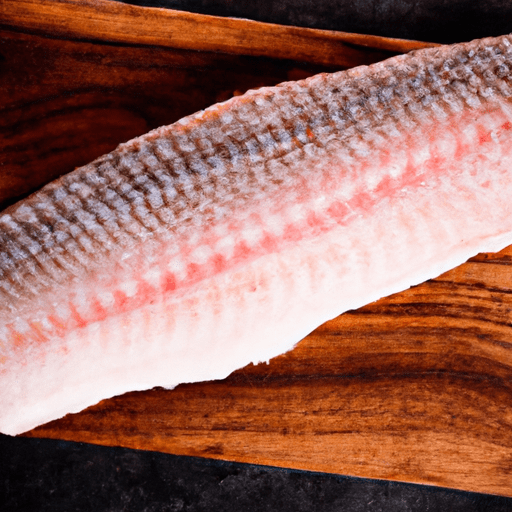The Delicate Delight of Sea Bass Fillets
When it comes to seafood, sea bass fillets are renowned for their delicate flavor, flaky texture, and versatility in the culinary world. Whether enjoyed in a fine dining restaurant or prepared at home, these fillets never fail to delight the taste buds. In this blog post, we will explore the characteristics, common uses, nutritional value, and fascinating facts surrounding this exquisite fish.
Taste and Texture
Sea bass fillets offer a sublime taste that is both mild and slightly sweet. The flesh has a buttery quality that melts in your mouth, making it a true delicacy. The texture is moist, tender, and flaky, making it easy to work with in various cooking methods, including grilling, baking, sautéing, and even steaming.
Culinary Versatility
Thanks to its delicate flavor, sea bass fillets are highly versatile in the kitchen. They can be easily paired with a wide range of ingredients and flavors, allowing for endless creative possibilities. Whether you prefer a light and refreshing dish or something more robust and bold, sea bass fillets can accommodate a variety of culinary styles.
Some popular cooking methods for sea bass fillets include:
- Grilling: Grilling imparts a smoky flavor while maintaining the natural tenderness of the fish. Brush the fillets with a marinade or a simple mixture of olive oil, herbs, and lemon juice for a mouthwatering experience.
- Pan-Seared: Pan-searing sea bass fillets with a touch of olive oil creates a crispy outer layer while keeping the flesh moist and tender. Accompany them with a flavorful sauce or herb-infused butter for a burst of added richness.
- Baked: Wrapping sea bass fillets in parchment paper with aromatic herbs and vegetables before baking creates a flavorful and moist dish. This method allows the fish to steam gently, locking in all the delicate flavors.
Nutritional Value
Aside from being a culinary delight, sea bass fillets also offer various nutritional benefits. They are an excellent source of protein, which supports healthy muscle development and repair. Sea bass fillets are also rich in Omega-3 fatty acids, known for their heart-healthy properties. Additionally, they provide essential vitamins and minerals, including Vitamin D, Vitamin B12, selenium, and potassium.
Fascinating Facts
Sea bass, also known as branzino or loup de mer in various regions, has an intriguing history. It has been cherished for centuries in Mediterranean cuisine, where fishermen have relied on its abundant availability and unique taste. In recent years, the popularity of sea bass fillets has grown globally, captivating food enthusiasts with its delicate and versatile characteristics.
Another interesting fact is that sea bass fillets are commonly used in Asian cuisine, particularly in the Japanese delicacy sushi. Its subtle flavor and buttery texture make it a perfect ingredient for sushi rolls, sashimi, and nigiri preparations.
Conclusion
Sea bass fillets are a true culinary delight, offering a mild flavor, tender texture, and countless culinary possibilities. Whether you enjoy them grilled, pan-seared, or baked, their delicate taste and versatile nature make them a favorite among seafood enthusiasts. With their nutritional value and fascinating history, sea bass fillets are an excellent addition to any food lover’s repertoire.
So, next time you find yourself at a seafood market or perusing a menu, consider giving sea bass fillets a try. They are sure to captivate your taste buds and leave you craving more of their delicate, melt-in-your-mouth goodness.
Sea Bass Fillets
Origin: Sea bass is a popular fish found in both saltwater and freshwater environments. The term “sea bass” is used to refer to various species of fish belonging to the family Serranidae and Moronidae. The specific origin of sea bass fillets can vary depending on the species and where it is caught. European sea bass (Dicentrarchus labrax) is commonly found in the eastern Atlantic Ocean and the Mediterranean Sea.
Common Uses: Sea bass fillets are highly prized for their firm, flaky texture and delicate flavor. They are versatile and can be cooked using various methods such as grilling, baking, pan-frying, or steaming. Sea bass fillets are often used in gourmet dishes and are a popular choice in many seafood recipes, including ceviche, fish tacos, seafood stews, and Asian-inspired dishes.
Nutritional Benefits: Sea bass fillets are a good source of lean protein, vitamins, and minerals. They are low in saturated fat and are a rich source of omega-3 fatty acids, which are essential for brain health and reducing the risk of heart disease. These fillets are also a good source of vitamins B6 and B12, as well as minerals like selenium and potassium.
Unique Properties: Sea bass fillets are known for their white flesh, which turns opaque and flaky when cooked. They have a mild, slightly sweet flavor that pairs well with a variety of seasonings and sauces. Sea bass is often sought after for its culinary qualities and is considered a premium fish. It is valued for its delicate texture, versatility in cooking, and ability to absorb flavors from other ingredients.
Historical Significance: Sea bass has been an important food source in many coastal regions for centuries. In ancient times, they were highly regarded by the Greeks and Romans. In fact, the Romans bred sea bass in aquaculture ponds, and the practice continues today. Sea bass also holds cultural significance in certain cuisines, such as Mediterranean and Asian cooking, where it is commonly featured in traditional dishes and festive meals.




Use the share button below if you liked it.
It makes me smile, when I see it.